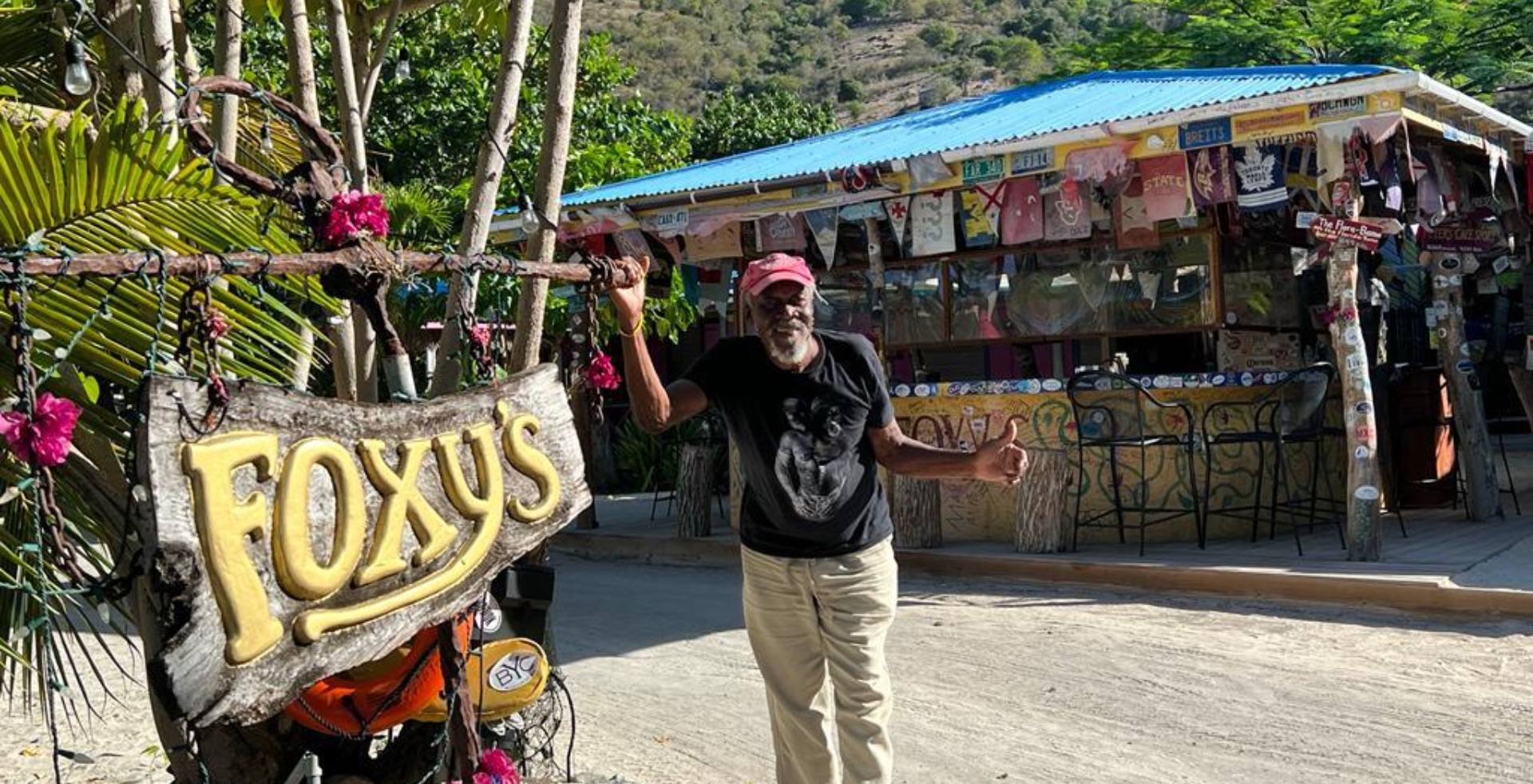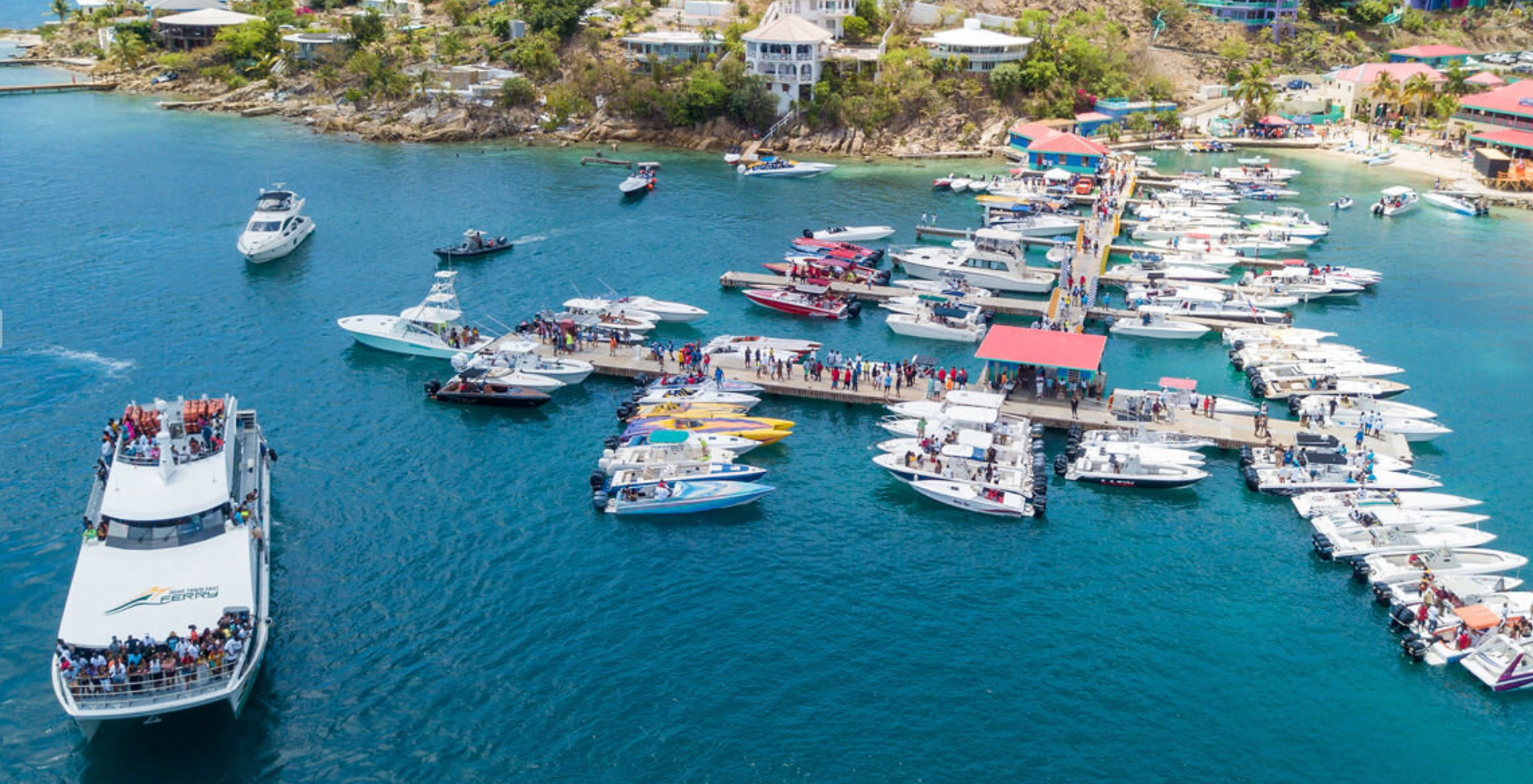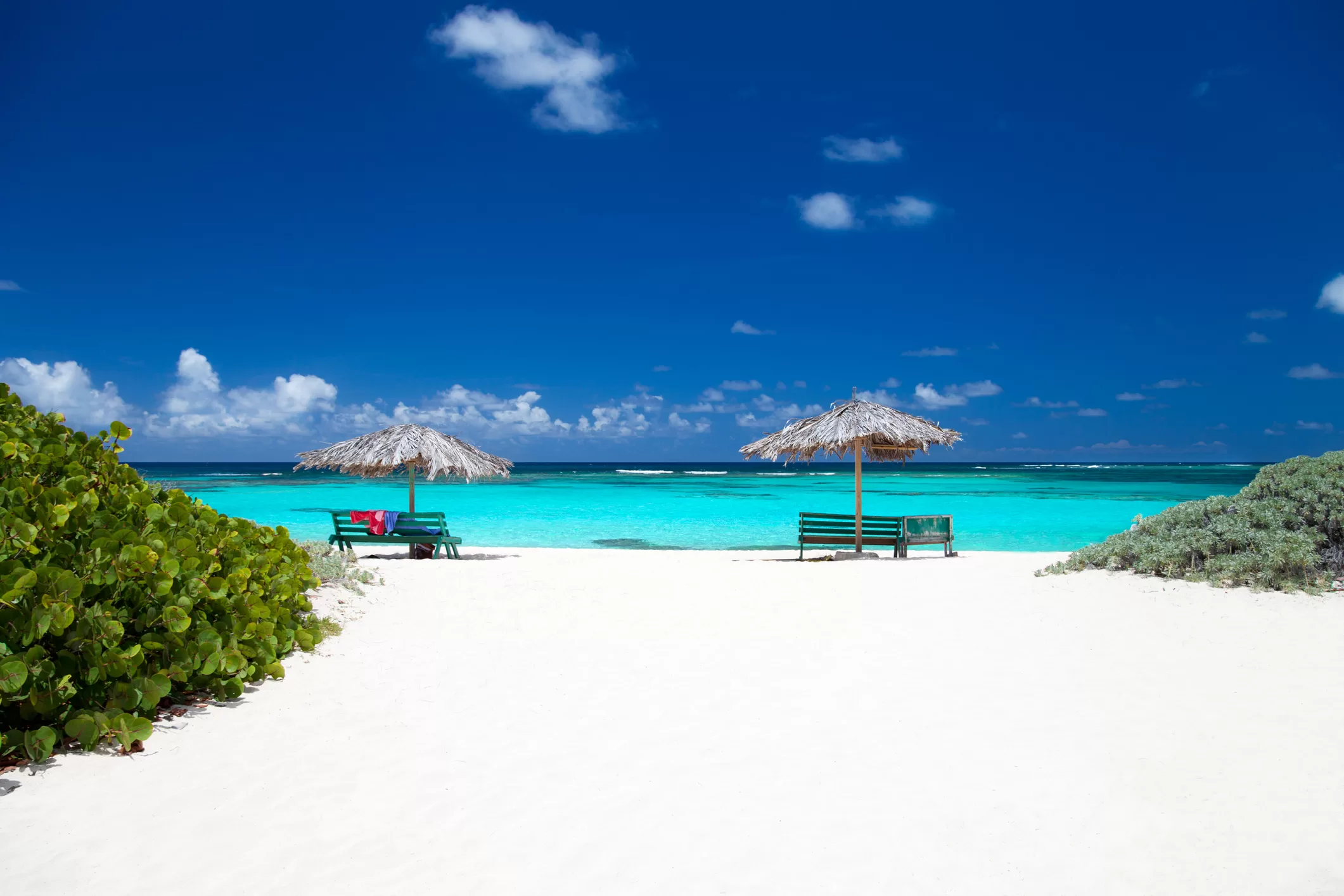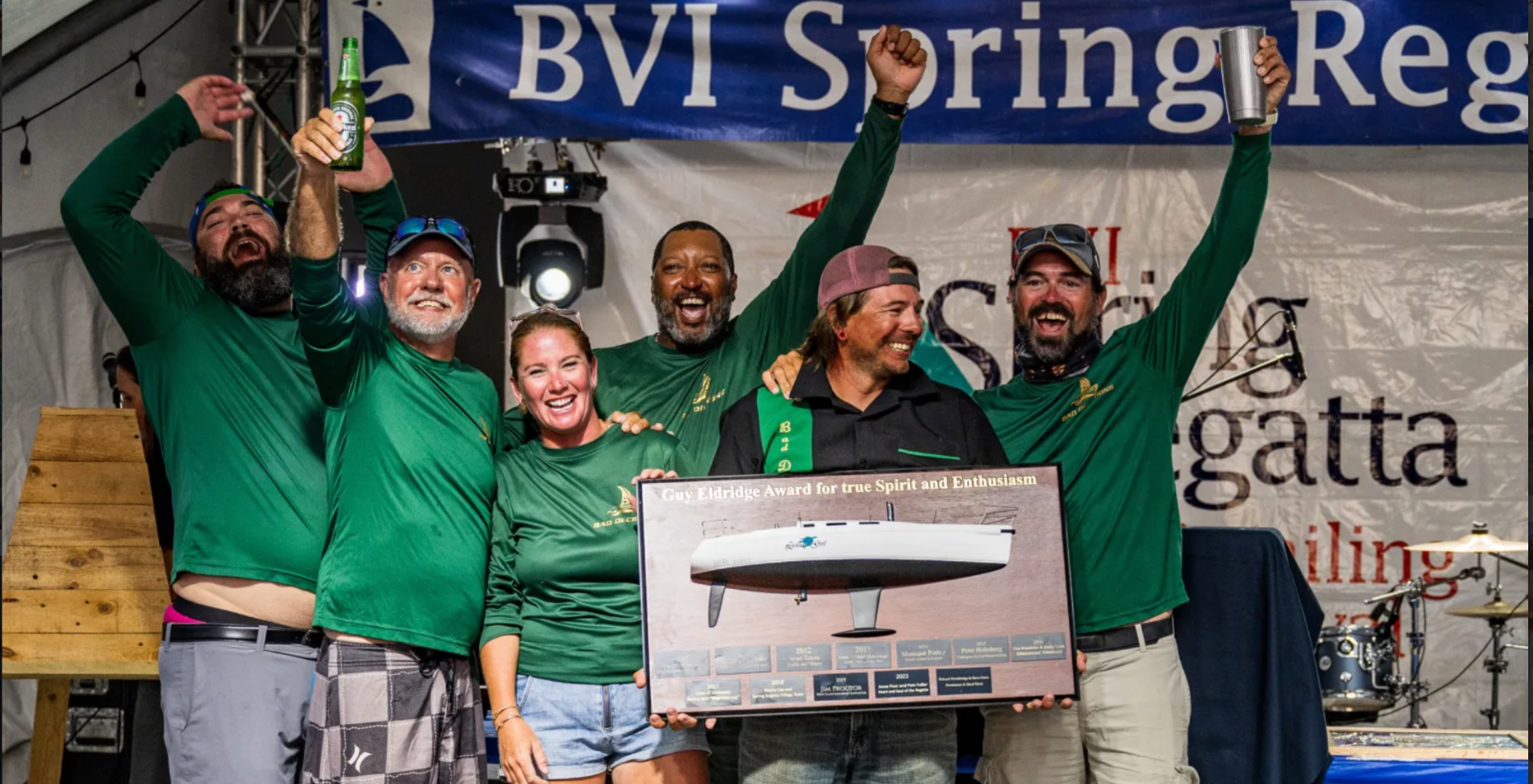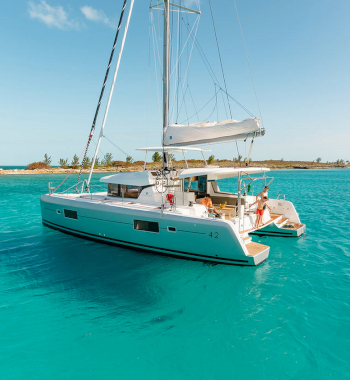Smooth Sailing for Triple Jack, A BVI Ocean Racer with 9-Lives
By Paul Carrell
Triple Jack will be one of the top BVI racing boats contending in the upcoming BVI Spring Regatta and Sailing Festival held from April 1st to 7th. But it hasn’t always been smooth sailing. Paul Carrell recounts the adventures of this elegant and fast ocean BVI racing trimaran, and how it has come back from catastrophe – more than once.
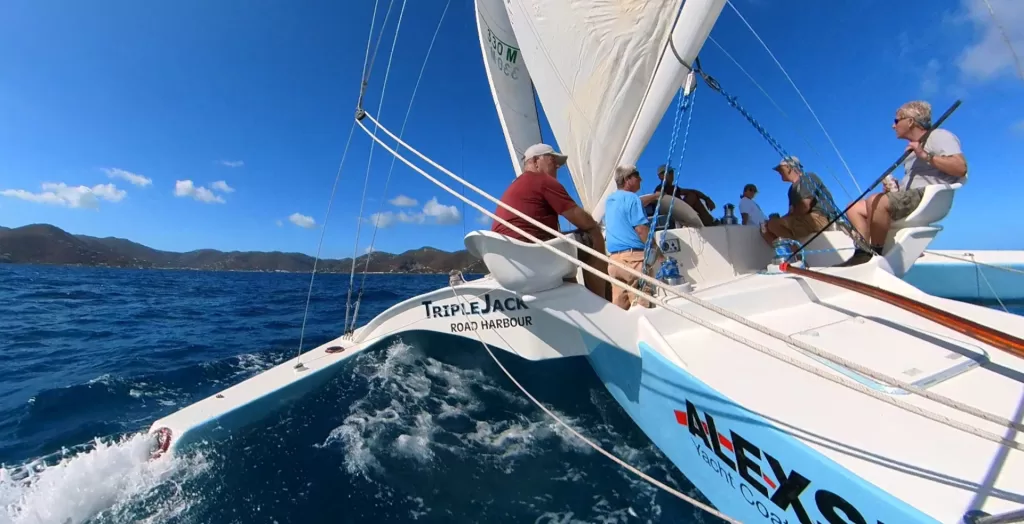
Mankind has been dreaming, whittling, chopping, shaping, and faring hulls from two meters and up for centuries. Sailors died, or became rich, married the natives on distant shores, or came home to sit in front of the fire. One thing for sure, there were tales to be told about the storms, whales, pirates and distant places.
While Triple Jack, a 47- foot Derek Kelsall trimaran built in 1979, is but a blip on the screen of naval history, its story is one of dedication and perseverance. In spite of challenges and setbacks, the boat’s owners, Richard Wooldridge and Steve Davis, decided to “remain calm and carry on”. This is their tale.
The story actually began in the Bahamas when Derek Kelsall decided to enter the 1964 OSTAR (Observer, Single-handed Trans-Atlantic Race) from Plymouth, UK to Newport, Rhode Island. He built the first unballasted vessel to compete in the race, Folatre, a 35-foot ketch rigged trimaran.
He almost won, however, five days into the race he hit a submerged object that tore off his rudder and centerboard. Returning to Plymouth for repairs, he later completed the race in 34 days.
In 1979, Frank Wood, an experienced offshore multihull sailor on the Trimaran Lydia Cardell commissioned Derek Kelsall to design an offshore racer which was eventually named Triple Jack. Triple Jack was built on the first floor of an old cotton mill in Ashton under Lyne. Kelsall’s design experimented with a canard centerboard system which consisted of two offset daggerboards. One was located just forward of the rudder. Once the hull was completed, they had to demolish an exterior wall in order to crane her out and down to a waiting trailer. This new lightweight unballasted trimaran with its rotating mast was a state-of-the-art ocean racer.
Frank Wood entered his new boat in the 1981 Twostar doublehanded race and nearly made it to the finish in Newport, R.I. Unfortunately for him about two hundred miles from the finish the rotating mast failed and came crashing down. A nearby freighter hoisted her up on deck, sailed her to shore and promptly dropped her a hundred feet back into the water when the lifting strap parted on the hoist to relaunch her. The boat survived and Frank was aboard her for the vertical drop. He survived too.
After re-rigging her with a conventional mast and completing another trans-Atlantic crossing and two Round Britain races, Frank Wood decided to sell her to Patrick Boyd Multihulls. It was later sold to a nefarious owner who was reported to have smuggled some bales here and there. Eventually the boat needed repairs and was left on a mooring near Powderham Castle in Devon.
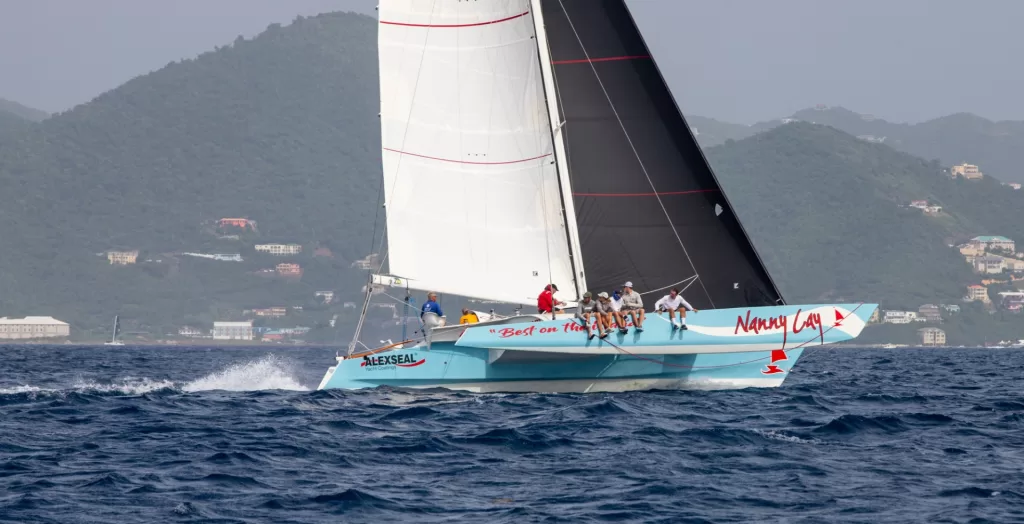
Richard and Steve Discover Triple Jack
When Richard and Steve came upon Triple Jack sitting dejectedly in the harbor they saw through the verdigris and appreciated her true value. Little did they foresee at the time that Triple Jack would someday become one of the top BVI racing boats.
Even though the boat was damaged and neglected, the dynamic duo made some inquiries, and once aboard, raised the tattered sails and soon discovered that the mast step was moving, bulkheads were cracked, cross beams were impacted, and the rudder stock was on the move, perfect! They found the owner and took her on.
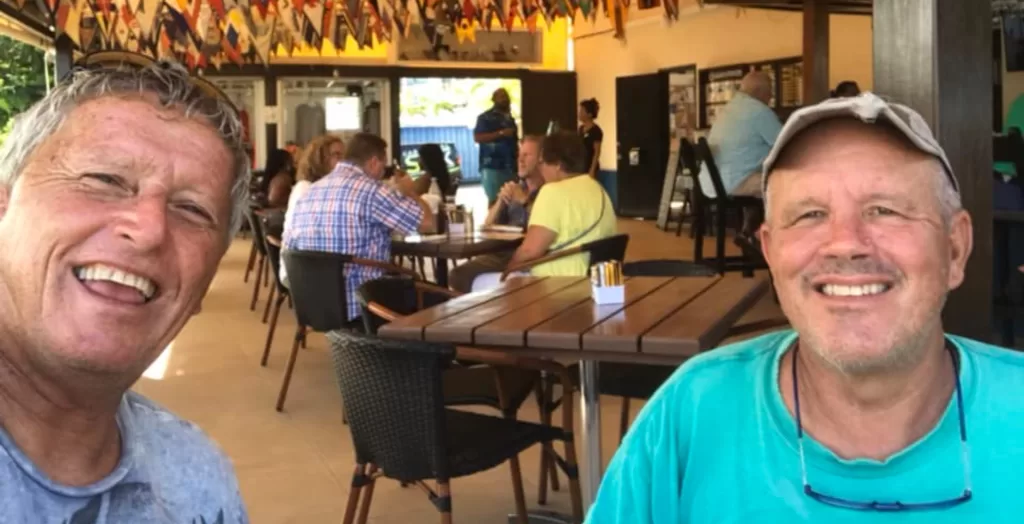
The epic adventure began. It would include bare pole sailing, grinding blisters, delamination’s and the acquisition of yards of fiberglass cloth and resin. In the early 1990s, Steve and Rich decided that after five years of teaching greenhorns how to sail, they had had enough, and closed their sailing school. They were now in possession of a large trimaran and decided to find some helping hands to make it ready for a trip to the verdant warmth of the Canary Islands.
So, on a winter day with a good weather window, they and three crew members departed Devon on what was to be the first of many offshore adventures. Overloaded with tools, fuel, gear and provisions, they sailed off. They radioed Brixham Coastguard to announce their intentions to sail directly to the Canaries. After a pensive pause the Coast Guard replied, “do you have an Epirb (Emergency Position Indicating Radio Beacon)? Yes, was the reply!
Three days out, a Northeasterly arrived 100 miles off Finisterre. They surfed down ten-foot swells off the island of Satriani while listening to Hendrix. By 1800 hours, it was really picking up and the boat was out of trim, so they shifted gear down below and reduced sail as they were in a full gale.
The boat resonated and vibrated as if she was possessed by demons, burying the leeward sponson (pontoon). This forced them to shift fuel and even more gear in the dark – all while underway in a gale. Not for the faint hearted! The storm continued to rage its fury, but by midnight the wind had eased and by sunrise they were under full sail with fishing lines out in glorious sunshine.
The trip took nine days, and 1500 miles later, they dropped the hook and replaced one of the unraveling backstays. Life was good, the crew departed and Steve and Rich based themselves at Los Christianos on the South Coast where they tried a hand at day sails until they were informed that the Spanish were cracking down on renegade day sailors, so they raised anchor and sailed on.
In 1994, Richard was offered a job at the Catamaran Company on Tortola, which was his introduction to the Leeward islands. Richard convinced Steve to make the trip over, and they sailed “TJ” from England in 1997. Racing her soon followed. They entered her in several regattas and made a name for themselves defeating the racers, Ptryst and Water Music, in the 2002 Heineken Regatta. The feat earned them the competition’s overall honors. People would remember Triple Jack as she passed them on the racecourse.
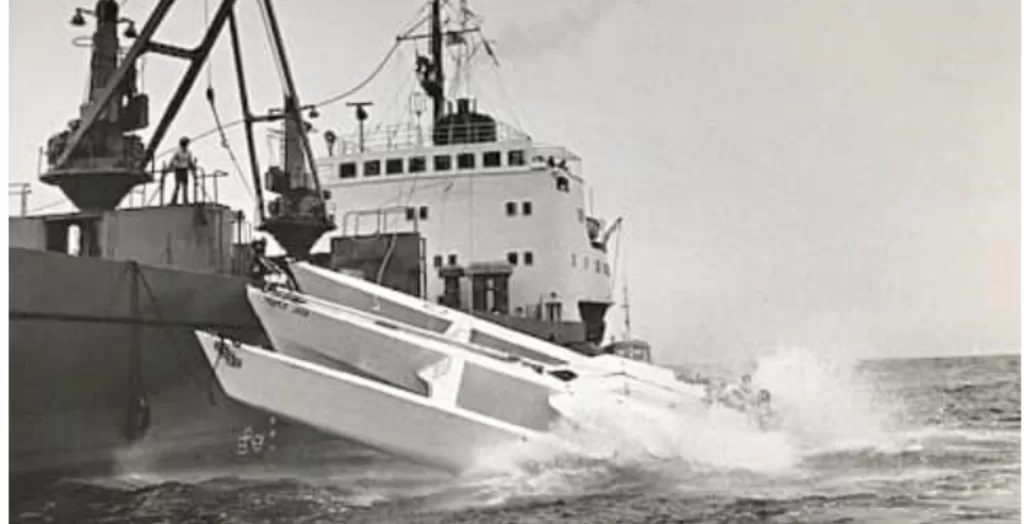
Hurricane Irma Wreaks Havoc
Wednesday September 6, 2017 a day of infamy for the British Virgin Islands. Supernatural winds, storm surges and flooding devastated people’s lives, homes, businesses, and dreams.
Nanny Cay Marina and Boatyard lay in ruins with hundreds of vessels either sunk or entangled with each other as they were blown over in its three storage yards. When the survivors remerged from the rubble they could see that the British Virgin Islands suffered catastrophic damage that would take years to rebuild. But rebuild it did, and this part of Triple Jack’s resurrection from the rubble reminds one of “The Flight of the Phoenix.” Richard and Steve decided it was worth saving the crumpled and broken vessel. So, over the next five years she was painstakingly rebuilt and rerigged better than ever before.
Prior to the storm, Triple Jack was located in the “new marina” on a mooring in the Northeast section of the outer channel. The first part of the storm flipped her over and placed her upside down on the concrete bulkhead by the mast rack in the adjacent storage yard. When the “back” of the storm returned after the eye wall passed, it somehow re-lifted the 47- foot trimaran’s 4500 kilos and sent her flying over the water. She was deposited five hundred yards downwind on the concrete bridge that provides access to the “peninsula” storage yard.
The port sponson was broken off at the bow and the starboard sponson was barely attached to the cross beams. The mast was gone and the boat was upside down half on the bridge and half in the water obstructing the road. When cranes were used to remove her, the starboard sponson was severed and the boat was trundled off to the side and left upside down for about a year while Richard, Steve, and the island struggled to rebuild their houses, lives, and businesses.
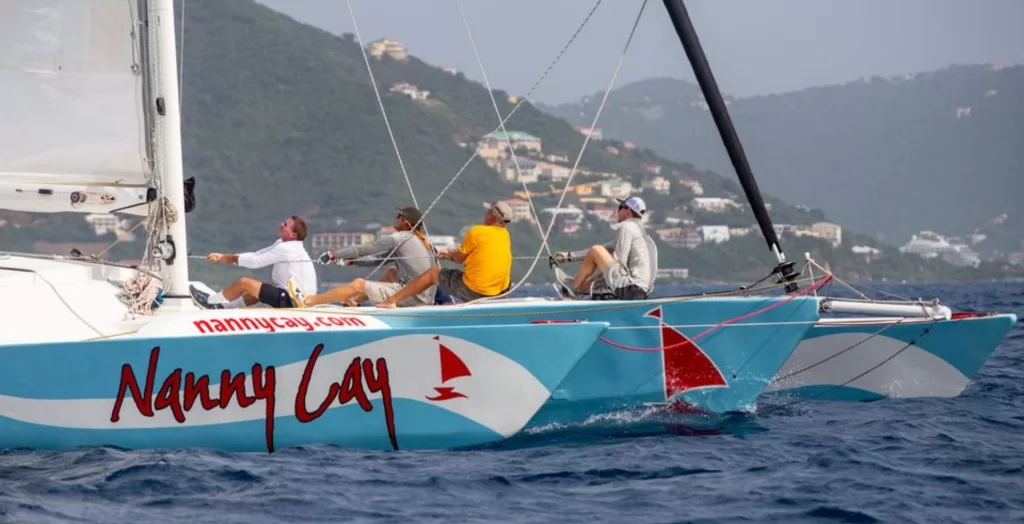
Gradually over time they formulated a plan which involved the re-attachment of the port sponson bow, the faring of the three overturned hulls, barrier coat and a coat of antifouling paint. They were fully aware that there was the rest of the boat underneath that needed unlimited expenses and a tenacious labor force. Once businesses and homes were rebuilt Triple Jack was finally moved in May 2019.
It required two cranes to lift and flip her over then one to trundle her over to a nearby site on the ‘Peninsula’ at Nanny Cay’s outer marina. Now that all the pieces were upright, the team could begin the arduous task for realigning the main hull with the severed starboard sponson. Since much of the severed glass mat was still in place the crew could gradually reposition the sponson to its original position. This task alone took about three weekends to accomplish.
Once in place Richard, Steve and Mike Hurst a surveyor had to determine the best way to laminate the hull and sponson back together in order to ensure that the repairs would be structurally sound, and the hull was correctly realigned. This was an arduous and time-consuming process. Hours of grinding fiberglass, rolls of fiberglass cloth, gallons of resin and adhesive fillers were used to insure she would safely sail again. Over time TJ’s hull began to take shape, however the super structure, deck, rig and chainplates still remained an unknown.
December 1, 2019
Thin pine battens were used to build a form over the center hull to define the complex shape of the new roof. When a favorable shape emerged, ¼” plywood was then laid on top of the battens, followed by a layer of plastic Visqueen. This created a barrier between the smooth “plug”, and the unidirectional cloth, resin and Divinacell foam core, which were used to make a very strong light weight foam cored roof structure. This would be removed and completed while upside down in the shop. The next time-consuming job consisted of fabricating curved laminated purple heart beams that would be laminated to the underside of the newly formed roof assembly. Once this was completed the entire roof structure could be painted prior to its eventual attachment to the hull structure.
With the roof now in place the crew proceeded with the hours of grinding fiberglass and renewal of the sponson, mast step, hatch placement. Other must do chores included cockpit layout and modifications, new chain plates, rudder post relocation, and should I mention, the addition of a diesel engine with a sail drive unit located amidships. Oh yes, then there was the modification of the newly acquired carbon rig and boom assembly that needed to be made prior to even considering stepping the rig.
The boat was now new and improved through the tenacity and fortitude of Richard, Steve and Paul Westlake. Westlake, a coworker and a stalwart volunteer, balked at nothing and ‘got on with it’. Bear in mind that all this was accomplished in the yard under a temporary roof structure with a small Honda generator, a portable water truck and beer cooler. Over time the new hatches were located and installed, winches were found, rebuilt and mounted.
May 1 2023.
The Mast is Up! Wickham’s Cay Rigging was on board with Isaac and his son, Dean Fonseca, in charge splicing Dynema shrouds and the necessary rigging bits.
When rigged, the boat could be lifted for the launch. Fitting the lifting dagger board, and rudder was soon accomplished, and she was launched May 16, 2023 to the cheers of the rebuilding crew. Once in the water the final work list was completed the shakedown cruise proved exhilarating
BVI Spring Regatta and Other Racing Adventures Ahead
Triple Jack is now back to racing. She competed in the Round Tortola Race last November, and is ready for the 15th edition of the RORC Caribbean 600, which will start on the 19th of February from Fort Charlotte, Antigua. She is also looking forward to showing off her racing chops in the upcoming BVI Spring Regatta and Sailing Festival to be held from April 1st to 7th.
They say “all good things come to an end”. Well in this case I believe that there will be numerous finish lines to cross and podiums to ascend to. It just goes to show you that given the tenacity, fortitude and vision, Triple Jack is back and better than ever. Well done mates!
Learn more about Triple Jack and watch her sail in the below video from Triple Jack’s FaceBook page:
https://www.facebook.com/watch/?v=228078676410899

